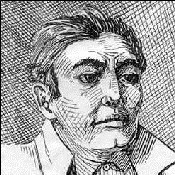
John Bender Sr.
Summary
Name:
John Bender Sr.Nickname:
Old beetle‑browed JohnYears Active:
1871 - 1873Status:
DeceasedClass:
Serial KillerVictims:
11+Method:
Bludgeoning / Throat slitting / DumpingNationality:
USA
John Bender Sr.
Summary: Serial Killer
Name:
John Bender Sr.Nickname:
Old beetle‑browed JohnStatus:
DeceasedVictims:
11+Method:
Bludgeoning / Throat slitting / DumpingNationality:
USAYears Active:
1871 - 1873bio
John Bender Sr.—often referred to as “Pa Bender”—was a towering, gaunt German immigrant in his early sixties when he established himself around 1870 in Labette County, Kansas, like many settlers drawn by the post–Civil War Homestead Act. Standing over six feet tall, his deep-set, piercing dark eyes framed by thick, bushy brows earned him the nickname “old beetle‑browed John.” His ruddy, bearded face and sullen demeanor made him appear wild and unapproachable, and his guttural, heavily accented English was difficult for neighbors to understand.
John’s companion—known as Ma Bender, Kate Sr., or Almira—was around 55 and equally ominous in presence. A heavyset woman rumored to have a tempestuous personality, she was nicknamed “she‑devil” by locals. Claiming to be a spiritual medium, she concocted herbal remedies and exuded an air of sinister mysticism that kept most people at arm’s length.
In the fall of 1870, John and his namesake son (John Jr., also possibly named John Gebhardt) homesteaded 160 acres along the Osage Trail—an isolated frontier route between Independence and Fort Scott. They constructed a cabin, barn, corral, well, and—by late 1871—Ma and daughter Kate joined. The cabin was divided with a canvas partition: the front served as a general store and inn, where travelers could buy goods or rest; the rear served as their living quarters. Ma and daughter Kate also cultivated a two-acre garden and orchard behind the home.
murder story
Between May 1871 and early 1873, a string of grisly disappearances and murders around Labette County, Kansas, turned the Osage Trail into one of America’s earliest frontier murder mysteries. It began when the body of a man named Jones was discovered in Drum Creek in May 1871—his throat cut, and skull crushed. Though suspicions briefly fell on the honorable Drum Creek claim owner, no charges ever followed. Fast forward to February 1872, and two more men were found dead on the prairie, bearing the same brutal injuries—killed with extreme violence, their bodies all but erased from memory. As word spread, travelers shunned the trail, which had already gained a sinister reputation for lawlessness and horse thieves. Vigilance committees formed, often rounding up the innocent in their frantic hunt—many were jailed or run off without trial.
In the winter of 1872, George Newton Longcor and his infant daughter, Mary Ann, vanished en route to a new life in Iowa. Their disappearance triggered alarm in the community. In spring 1873, Dr. William Henry York—a doctor and brother of a Kansas state senator—rode out from Independence searching for Longcor. York’s trek ended in silence; he never reached home. When Colonel Alexander M. York, a Civil War veteran and Kansas senator, organized a group to investigate, they questioned every homestead along the trail, including the Benders’ cabin. John Sr. and his clan claimed York’s brother had dropped by but was likely waylaid by Indians. York, trusting their pitch, ate dinner there in late March before departing.
Alarm bells rang again on April 3 when York returned with armed men, prompted by a woman's report that Ma Bender had threatened her with a knife. The woman’s account exposed Ma's feigned inability to speak English—later revealed to be an act when she angrily rebuked the claim, accusing the woman of witchcraft. Before leaving, Kate invited York to return alone the following Friday so she could help him find his brother through "clairvoyance." York rejected the offer on the basis of principle and suspicion.
As tensions mounted, a meeting held in the nearby Harmony Grove schoolhouse drew seventy-five locals—including the Yorks, and possibly both Bender men—to demand warrants and searches. But it was too late: in the days that followed, the Benders vanished.
Their disappearance was discovered three days later by cattle driver Billy Tole, who noticed the Bender property deserted and its animals unfed. A volunteer posse—and Colonel York—arrived at the cabin to find it stripped of all provisions. A foul stink emanated from beneath a nailed-down trapdoor beneath a bed. Breaking it open, the search party exposed soil stained with dried blood, too deep to ignore. They lifted the cabin and dug beneath, eventually probing the surrounding garden and orchard. By nightfall, York’s men unearthed the body of Dr. York buried face-down, partially covered. They marked nine possible graves before night fell.
The following day, they recovered eight bodies from seven graves—and one tossed into the well, along with dismembered parts. Nearly all victims had fractured skulls and slit throats; newspapers described them as “indecently mutilated.” Among the macabre finds: the body of a young girl with no visible fatal injuries—raising fears she was buried alive or strangled. A frenzy followed: one man named Brockman—friend of the Benders—was lynched, revived, interrogated, then nearly lynched again before collapsing home in a daze.
Inside the cabin, investigators found an old Roman Catholic prayer book with German notes: cryptic entries like “Johannah Bender. Born July 30, 1848,” “big slaughter day, Jan eighth,” and “hell departed”—etched with ominous flair. News of the atrocity spread fast—more than 3,000 people, including reporters from New York and Chicago, flocked to the site. Souvenir-seekers tore the cabin apart, stripping bricks and stones for keepsakes. Authorities upped the ante: State Senate Alexander York offered a $1,000 reward, and Governor Osborn added $2,000 more—but the killers had already fled.